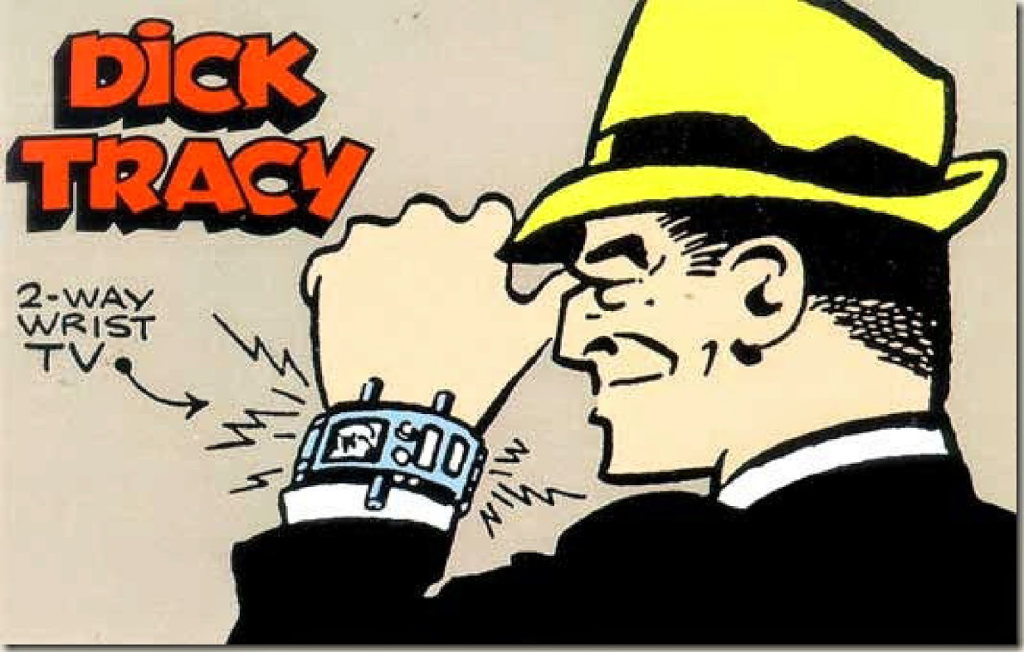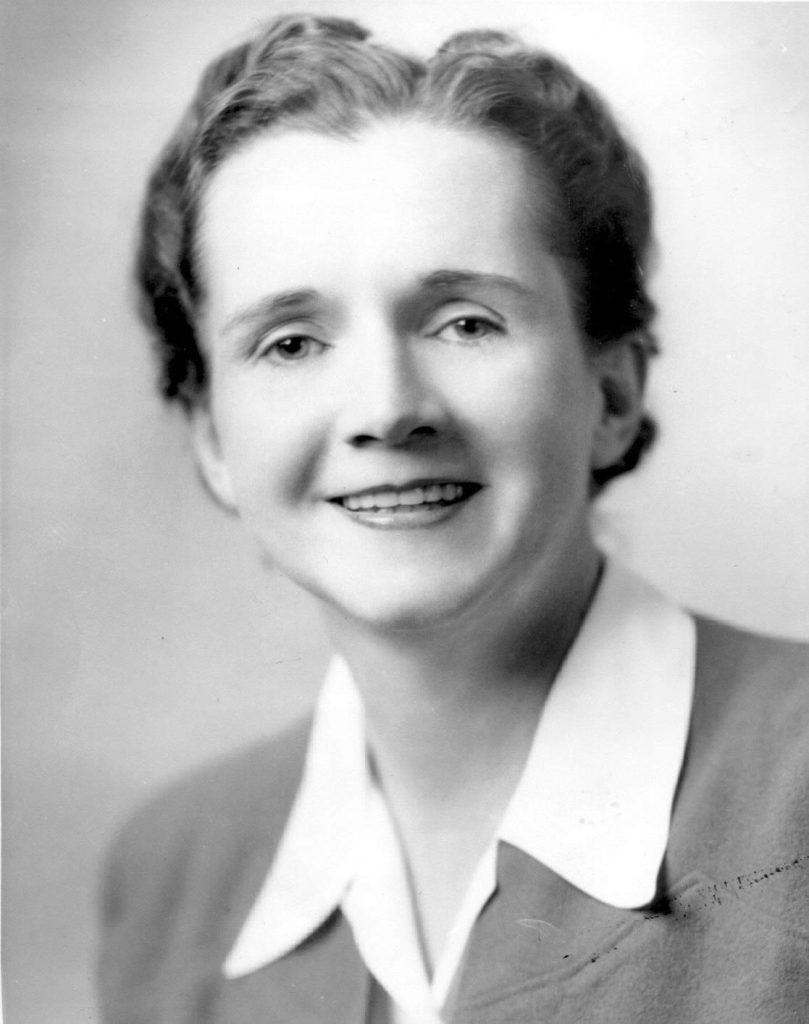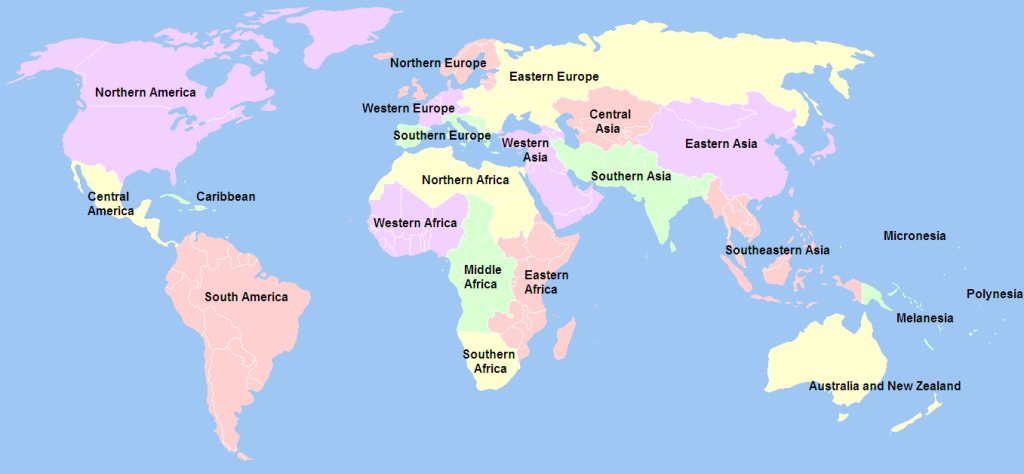
Alan Hall begins his 1999-05-03 article, Hello, This is Dick Tracy, in Scientific American, with: Cartoon detective Dick Tracy has been calling on his wristwatch radio to get out of sticky situations since 1946. Back then, when a two-way communication was about as portable as a filing cabinet, it was pretty amazing stuff–and it had the comic strip’s young fans mumbling into toy watches for years.
Technology improves, or at least changes, and this weblog post is published on the 60th anniversary of Dick Tracy’s 2-Way Wrist TV, that first appeared in the comic strip on 1964-04-24.
Cartoonist Chester Gould’s (1900 – 1985) created the Dick Tracy comic strip. It was first published 1931-10-04. Gould received permission to use Al Gross’ (1918 – 2000) concept of a miniaturized two-way radio. It first appeared 1946-01-13.
In Dick Tracy’s world, the 2-Way Wrist Radio was an invention of industrialist Diet Smith’s son, Brilliant. Like many of Smith’s inventions, it was only available to the MCU = major crime unit, of the police. It allowed audio communication, and was powered by a strong atomic battery. An aerial wire ran up the inside of the wearer’s sleeve. It was considered superior to bulky walkie-talkies or other radio devices, and was used very effectively by Dick Tracy and others involved with law enforcement.
The 2-Way Wrist TV was an upgrade developed by Diet Smith Industries. It allowed users to transmit images of themselves, rather than only their voices. It also featured a 180-degree range of vision and an atomic light. The Wrist TV coincided with Dick Tracy’s first adventures with the Lunarians of Moon Valley.
In 1984, the criminal known as Big Brother developed a technology that could intercept transmissions made via the 2-Way Wrist TV which enabled him to monitor the activities of Dick Tracy and the MCU. He sold his technology to members of the criminal underworld, but was eventually caught and arrested.
After Gould died, the 2-Way Wrist TV was upgraded to a 2-Way Wrist Computer by his successors writer Max Allen Collins (1948 -) and illustrator Dick Lochner (1928 -2017) on 1986-06-13. Once again, in the fictional world, this upgrade was developed by Diet Smith. It added a long-range wireless datalink that allowed the wearer to have easy access to various databases for fingerprints, license plates, firearms and more. It also incorporated a lie detector and a probe for on-scene chemical evidence analysis.
At some, for me unknown, point, 2-Way was removed from the description of wearable devices. The Wrist Computer constantly monitored the wearer’s heartbeat to guard against unauthorized usage of the device (since the heartbeat is as distinctive as a fingerprint). This feature also worked with a homing device to enable police dispatch to be immediately alerted that the wearer required assistance if the detected heartbeat showed irregularities or stopped.
The Wrist Computer was later upgraded with the ability to read micro data discs, referred to as a Wrist-Disc.
The next improvement was the Wrist Geenee, introduced 1997-03-26 by Mike Kilian (1939-2005), who had taken over as writer in 1993, and Dick Lochner. In the story world, this upgrade was developed, once again, by Diet Smith. Shortly after Dick Tracy was presented with a prototype, it was stolen off his desk by Rocksie. Rocksie used the Geenee’s holographic projector to free Nutsy and his gang from jail. They then used the Geenee to commit more crimes.
The Geenee included RADAR and SONAR capabilities, holographic projection, an ability to trace phone numbers, heat/ motion sensors, GPS link, laser and X-ray capabilities, computer password detector/decoder that could accurately sense a safe’s lock combination.
Tracy tracked Nutsy, Rocksie, and the rest of their gang to a store that they were attempting to rob. Rocksie threw the Wrist Geenee at Tracy, who caught the delicate prototype. Rocksie escaped, but Nutsy and his gang were arrested.
A later version of the Wrist Geenee had a taser. Tracy continued to use the Wrist Geenee for several years until it was upgraded to the Wrist Wizard, yet another invention of Diet Smith. Detective Frisk kept her Wrist Geenee after she was abducted by Clair Howell. She used it to contact Dick Tracy. He was initially puzzled to receive a message coming from outdated technology.
The Wrist Wizard was introduced by writer Mike Curtis (1953 -) and illustrator Joe Staton (1948 -) on 2011-07-06, during Dick Tracy’s encounter with B-B Eyes, previously presumed-deceased. In addition to features in previous devices, including two-way video communication, GPS, a National Crime Information Center (NCIC) link, it also came with a light-projected keyboard, and responded to eye blinks when its user was injured/ incapacitated.
Diet Smith issued a Wrist Wizard to his goddaughter, Honeymoon Tracy, who was also Dick’s granddaughter and the daughter of his adopted son, Junior. She used it during her encounter with B-B Eyes. Shortly after that, Blackjack was able to steal Dick Tracy’s Wrist Wizard, to add to his collection of Tracy memorabilia.
Some time later, the MCU’s Wrist Wizards were re-fitted into casings that made them resemble the original 2-Way Wrist Radio. Earlier models had faulty batteries that could explode. This was a factor in Tracy’s defeat of Mr. Bones, who was using Blackjack’s outdated Wrist Wizard.
In 2011, Tracy and the MCU temporarily reverted to using 2-Way Wrist Radios so they could communicate without having their calls intercepted by the high-tech devices being used by Willie the Fifth and Flyface.
In 2016-12, Tracy’s Wrist Wizard suffered an explosive malfunction which prompted Diet Smith to issue a safety recall. The Wrist Wizard was replaced by a Wrist Communicator that superficially resembled a 2-way Wrist Radio, but with many of the equivalent functions of the newer design.
Much of the above content was taken from the Dick Tracy section of the Fandom website.
The Real Dick Tracy Wrist Radio Watch

In 2015, Nick Mathis made a Dick Tracy watch prototype in his workshop, an apartment closet, using Fusion 360 and a desktop CNC machine. Shapeways was used to 3D print it. In 2016, Nick and Charlie Mathis purchased a license from the Dick Tracy rights holders, TMS News & Features, LLC.
Fusion 360 is digital prototyping software, incorporating commercial computer-aided design, manufacturing, engineering and printed circuit board software. It comes in Windows, macOS and web browser standard versions , as well as simplified versions for Android and iOS. It was developed by Autodesk, best known for their AutoCAD software.
Shapeways is a New York based, but global, 3D printing service, publicly traded company, with Dutch origins. Users design and upload 3D printable files. Shapeways prints the objects. It can also provide marketing services, where needed. Objects can be printed in about 55 different materials and finishes, including plastics and precious as well as non-ferrous base metals.
In 2018, the Mathis brothers created a working Dick Tracy watch with an integrated Bluetooth module, microphone and speaker. It can be considered a Wrist Radio, because it allows users to make and receive calls from a paired smartphone. Yes, that means that it will not work independently of a smartphone.
In addition to an oil-tanned leather strap, the device has a vintage styled stainless steel body, sapphire crystal face, and a mesh grill to cover speakerphone components. It also has a button to activate a voice assistant.
On 2018-07-13 the Mathis brothers, through their company Ivory & Horn, had received pledges of USD 106 490 of a goal of USD 30 000 on Indiegogo from 321 backers. On 2020-11-20, Nick Matis reported that all watches had been shipped! he concluded with …
Thank you.
It was a wild ride for you and, while I am relieved to wind it down for us both, I am also grateful for the opportunity to deliver our analog watches to such a passionate and generous group of people. I hope it brings you as much joy as it does me for many years. Thank you.
This campaign and the first analog 2016 model would not have been possible without my brother Charlie and our investor. I cannot understate my gratitude for the risk they took, the patience they showed, and the perseverance they maintained in trying to make the world’s first “real working” Dick Tracy watch come to life for us all. In the end, we did make a watch and I am very proud to have shared it with people all over the world. Thank you.
Onward and upward to the next project, folks.
Over and out,
Nick Mathis
Other Wristware
I am no longer tempted to own any wristware, including a Dick Tracy Radio, TV, Computer, Disc, Geenee, Wizard or Communicator. Both Trish and I have owned Wyse watches, but our enthusiasm for them died almost immediately. They occupied less volume than a smartphone, but did not offer anywhere near the same functionality. Our compromise is to use a small smartphone, currently an Asus Zenfone 9, and to wear clothing with pockets that will hold them, when they are not in use.
We have younger family members and friends who do use wristware. The main advantage is that these can be used when exercising to measure distances and elevation differences, especially when walking/ running/ skiing on trails.



